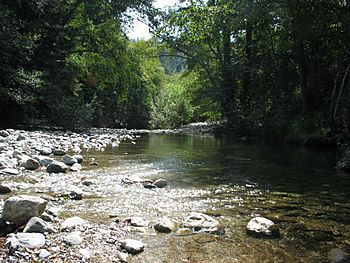Big Sur River facts for kids
Quick facts for kids Big Sur River |
|
|---|---|

Big Sur River as it passes the campgrounds
|
|
| Country | United States |
| State | California |
| Region | California Central Coast |
| County | Monterey County |
| Physical characteristics | |
| River mouth | Pacific ocean 0 ft (0 m) 36°16′49.87″N 121°51′35.84″W / 36.2805194°N 121.8599556°W |
| Length | 15.7 mi (25.3 km) |
| Basin features | |
| Tributaries |
|
| Type: | Wild |
| Designated: | June 19, 1992 |
The Big Sur River is a 15.7-mile (25.3 km) long river in California. It flows through the beautiful Big Sur area. This area is known for its tall Santa Lucia Mountains that meet the Pacific Ocean.
The river starts high up in the Ventana Wilderness. It then flows through Pfeiffer Big Sur State Park and Andrew Molera State Park. Finally, it reaches the Pacific Ocean at the Monterey Bay National Marine Sanctuary. The river's water comes from a large area of about 60 square miles (155 sq km). This area is mostly within the Los Padres National Forest. It's the biggest river in the Big Sur coast area by how much water it carries.
Contents
What's in a Name?
How Big Sur Got Its Name
The name "Big Sur" comes from Spanish explorers. In 1769, the Portolá expedition arrived in California. They found it hard to travel along the coast. So, they went inland through valleys.
The Spanish called the large, unexplored coastal area to the south el país grande del sur. This means "the big country of the south." People often shortened it to el sur grande. The two main rivers were named El Rio Grande del Sur (Big Sur River) and El Rio Chiquito del Sur (Little Sur River).
The first time "el Sud" (meaning "the South") was written down was on a map in 1834. This map was for a land grant called Rancho El Sur. Later, in 1851, the U.S. Coast Survey used the name "Sur" for Point Sur. This point of land looked like an island.
River Flow and Water
How Much Water Flows?
The Big Sur River gets its water from rain and snow. The higher parts of Big Sur can get over 50 inches (127 cm) of rain each year. This is about 10 inches (25 cm) more than lower areas.
On average, the river carries about 65,000 acre-feet (80,000,000 cubic meters) of water each year. An acre-foot is enough water to cover one acre of land with one foot of water. This shows how much water the river has!
There are no dams or reservoirs on the Big Sur River. Some water is taken for homes. There's also a debate about whether wells from a ranch are taking water from the river.
Old Plans for a Dam
A Dam That Was Never Built
In the late 1800s, a company called Ventana Power Company had a sawmill near what is now Pfeiffer Big Sur State Park. They planned to build a dam on the Big Sur River. They wanted to sell electricity to the city of Monterey.
They started building a channel along the river to move water. But then, the 1906 San Francisco earthquake happened. This disaster caused the company to lose all its money. They had to stop the dam project. You can still see some of the old stonework from their channel today!
A Special River
Wild and Scenic River Status
A 19.5-mile (31.4 km) part of the Big Sur River is very special. It is named a Wild and Scenic River. This means it is protected to keep its natural beauty. This protected part goes from where the river starts down to the edge of the Ventana Wilderness.
Plants and Trees
What Grows Along the River?
The area around the Big Sur River has many different kinds of plants. Along the river, you can find California sycamore and white alder trees.
Tall, old redwood trees grow in the moist canyons and on slopes that face north. Above the redwoods, there's a forest with different hardwood trees like madrone, tanoak, coast live oak, and canyon oak. You might also see ponderosa and Coulter pine trees.
A rare tree called the Santa Lucia fir grows only in the Santa Lucia Mountains. You can find some of these special trees near where the Big Sur River meets Ventana Creek. This is the lowest place they are known to grow in the wild.
On higher, steep, and south-facing slopes, you'll find chaparral. This is a type of scrubland with plants like chamise and manzanita. Some ridgetops also have grasslands and open pine forests.
Fun Things to Do
Exploring the Big Sur River
The popular Pine Ridge Trail is about 26 miles (42 km) long. It follows the Big Sur River for several miles inland. Along the river, there are several places where you can camp in the backcountry. These include Ventana Camp, Barlow Flat Camp, and Sykes Camp.
Near Sykes Camp, about 10 miles (16 km) inland, there are popular hot springs above the riverbank. It's a great spot to relax!
From Sykes Camp, the trail crosses the river. About 3 miles (4.8 km) later, you reach Redwood Camp. This camp is along a smaller stream called Redwood Creek. From here, the trail climbs over 3,000 feet (910 m) to Pine Ridge. It then enters the Carmel River area.
As of 2017, parts of the trail were closed. This was due to damage from the Soberanes Fire. This fire started from an illegal campfire.

